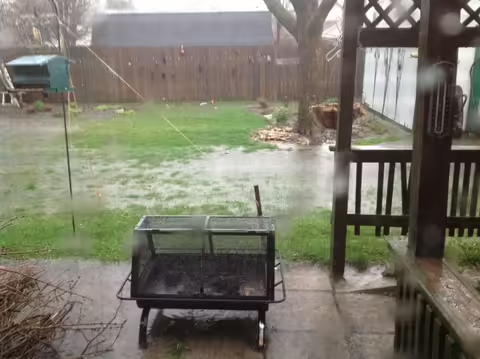URBANA, Ill. – The splendor of trees and shrubs comes from what is above ground, but don’t forget about what lies beneath. Poorly drained areas, easily identified after a downpour of rain, are not suitable for some trees or shrubs.
“Soil plays a vital role in the survival of trees and shrubs in the landscape,” says Andrew Holsinger, University of Illinois Extension horticulture educator serving Christian, Jersey, Macoupin, and Montgomery counties.
Planting the right trees and shrubs in poorly drained sites has many benefits. Roots take up excess water and promote improved soil filtration. Reducing standing water can help decrease mosquito populations and create a more pleasurable environment. Surface drainage may be preferred over sub-soil drainage, which is limited or slow. Moving the water away is a great start.
When deciding on a new tree for a wet area, think up and down, imagining both the mature canopy and the expansion of the root system.
“Trees that do well in wetter soils often have a shallower root system, so be prepared to find those roots at or near the surface as the tree matures,” says Holsinger.
Placement will be pivotal for tree success, especially when planting in wet soils. Soil texture, or the ratio of sand, silt, and clay in the soil, influences soil moisture retention. Soil texture also influences aeration, how air moves through the soil. Avoid heavy clay soils, which have poor aeration and drainage, and hardpan soil, which is underlaid with rocky material that can interfere with root development.
Do not plant trees in wet areas in the fall. One threat to planting in wet soils is frost heaving, an upward swelling of the soil during freezing conditions caused by ice formation in the pore spaces of soils.
“Plant trees and shrubs on wet sites during the early spring to ensure a full season of growth and reduce the likelihood of frost heaving that happens with a fall planting,” says Holsinger.
Other placement considerations include precipitation patterns and poorly-timed or located irrigation systems. Downspout rain discharge may also influence the suitability of a planting site.
Looking at the distribution of trees in the wild can also help guide plant selection. However, some species such as bald cypress or black gum can adapt to heavy moisture and other growing conditions that may not occur where they are naturally found.
Research to find out what the requirements for moisture are when selecting trees and shrubs. Prior performance will also indicate what trees or shrubs may be successful in your landscape.
“It is much more cost-effective to plant the right species for the location than to try to adjust the site conditions,” says Holsinger.
Trees and shrubs that thrive in wet sites include:
- Downy serviceberry, Amelanchier arborea
- River birch, Betula nigra
- American hornbeam, Carpinus caroliniana
- Common hackberry, Celtis occidentalis
- Dawn redwood, Metasequoia glyptostroboides
- Black gum, Nyssa sylvatica
- Bald cypress, Taxodium distichum
- Buttonbush, Cephalanthus occidentalis
- Gray dogwood, Cornus racemose
- Redosier dogwood, Cornus sericea
- Spice bush, Lindera benzoin
SOURCE: Andrew Holsinger, Horticulture Educator, University of Illinois Extension
ABOUT EXTENSION: Illinois Extension leads public outreach for University of Illinois by translating research into action plans that allow Illinois families, businesses, and community leaders to solve problems, make informed decisions, and adapt to changes and opportunities.
PHOTO ACCESS: The photo in this article is available to download for media use.
